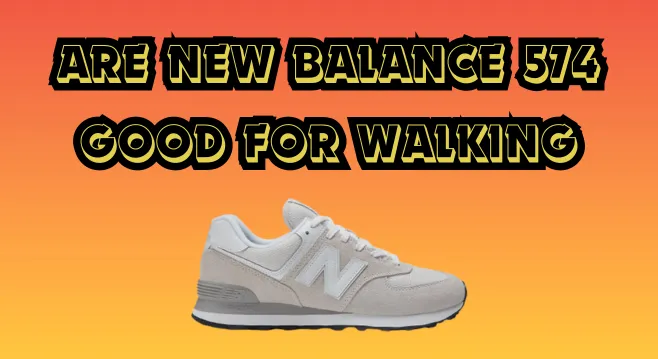Picture this: You’re on the hunt for a casual, comfortable sneaker to wear for all those steps you log just going about your daily life. Something stylish yet practical for running errands, power-walking around the neighborhood, hitting up weekend street fairs and the like.
Your eyes can’t help but drift towards the iconic New Balance 574 and its clean, retro style. But can that classic kick really hack it for serious walking?
That’s what we’re here to find out! The New Balance 574 is undoubtedly one of the most popular lifestyle sneakers around, beloved for its vintage suede/mesh upper and quintessential dad shoe look. But what about utilizing that world-famous 574 model as a dedicated walking shoe?
We all know looks can be deceiving in the shoe world. So let’s break down whether these old school 574s have what it takes to keep your feet happy mile after mile, or if you’re better off looking elsewhere for a dedicated walking sneaker.
The Case For Using the 574 for Walking
NB’s 574 definitely has some qualities that lend themselves well to walking:
Classic Cushioning
While far from a high-end cushioning system, the basic foam midsole and ENCAP technology in the 574 provides a decent level of impact protection for just pounding the pavement. You’ll get a nice layer of shock absorption between your feet and the concrete.
That tried-and-true New Balance cushioning is a major selling point for those planning on spending a good deal of time on their feet. It gives you comfort for casual, moderate distanced walks without breaking the bank.
Versatile Traction
Another point in its favor – the 574’s rubber outsole does a pretty solid job at providing reliable traction for both dry and wet conditions. You’ll be able to get solid footing whether you’re walking on sidewalks, light trails, streets, etc.
Rather than specialized lugs or patterns, the 574 outsole goes for straightforward multi-directional tread geometry that works well for straight walking and everyday use. It’s a versatile ground connector.
Classic Lightweight Comfort
Don’t overlook the lightweight comfort factor! With their low-top suede/mesh upper and streamlined shape, 574s are extremely soft and flexible right out of the box. You’ll experience minimal break-in time or stiffness.
These are shoes that feel like slippers as soon as you slip them on. For all-day wear during casual neighborhood walks, park strolls, running errands on foot, etc. – that light and broken-in comfort is clutch.
And the mesh paneling provides solid breathability to help keep your feet cool and arid during longer walks.
Timeless Style
Of course, we’d be remiss not to mention the timeless, go-anywhere style of the 574 that makes it so popular to begin with. That perfectly distressed vintage suede and classic 70s-inspired look allows you to seamlessly blend function and fashion.
Who says you can’t get a great walking shoe that looks sharp and stylish? With a variety of colors to choose from, the 574 adds sophisticated flair to any athleisure or casual outfit.
Durability
Thanks to the premium suede/mesh upper materials and durable rubber outsole, 574s have proven to be fairly hard-wearing sneakers suitable for extended walking.
You can expect to get hundreds of miles of use before these need to be resoled or replaced. So from a value and longevity standpoint, you’ll definitely get your money’s worth treating them as a typical walking shoe.
Respectable Stability
While not on the supreme stability level of a dedicated motion control or orthopedic walking shoe, the 574 does provide a fairly stable base for casual walks and standing periods.
The classic saddle design through the midfoot helps lock down your foot, while added rubber elements and structured heels help prevent excess lateral wobbling as you stride. It’s nothing revolutionary but reliable for basic ambulation.
So in summary, the New Balance 574 has a lot working in its favor for casual urban walks and daily step counts! It’s a well-cushioned, versatile, and lightweight sneaker built to last.
The Drawbacks of Walking for Long Periods in 574s
Of course, even with all those positives, the 574 wasn’t necessarily designed from the ground up as a dedicated walking shoe. So it does have some shortcomings when it comes to hardcore ambulation:
Lack of Focused Walking Tech
First and foremost, while classic 574s can walk the casual walk pretty well, they lack any focused walking-specific technology baked into their build.
Things like reinforced motion control components, robust shanks, deep flex grooves, shaped footbeds, specialized roll bars – the 574 doesn’t have these embedded anatomical aids to enhance your natural walking stride and reduce fatigue over time.
So while amply cushioned, it’s not precisely engineered like a shoe intended solely for high mileage urban trekking or hiking would be. It’s a bit more generalized in its functionality.
Mediocre Arch Support
Speaking of footbeds, the 574’s flat, removable insoles leave something to be desired in the arch support department for serious walkers. At best they provide moderate contouring for low/neutral arches.
But for walkers who need more substantial arch reinforcement to prevent plantar fasciitis and other stability issues from overpronation/supination, the 574 may not have enough built-in support to avoid issues over time and distance.
Better for walkers whose arches don’t require intense stabilization, but limiting for long treks if you need focused arch support.
Not Great for Wide Feet
Another common gripe from some walkers wearing 574s is that the toe box can run a tad narrow and snug, especially for those with wider or thicker foot dimensions.
While the suede uppers do have a bit of flexible give, the rounded toe can cramp wider forefeet and cause painful rubbing if not properly sizing up. Not ideal for combating issues like bunions or allowing proper toe splay during long walks.
Heavy Duty Hikers Will Want More
Finally, while 574s can definitely handle casual pavement pounding and fair weather urban walks, they aren’t quite rugged enough for extremely hardcore hiking adventures over more technical trails, steep terrain, etc.
Their soft cushioning will compress excessively on rocky surfaces, while the flat outsole lacks the aggressive grip and shank protection required for tackling major elevation changes. Best to save 574s for flatter walks around town and paved routes.
The Bottom Line on Whether 574s Are Good Walking Shoes
At the end of the day, the New Balance 574 makes for a completely respectable kick for casual and moderate distance walking around town and urban settings! The comfortable cushioning, reliable traction, classic style, durability, and lightweight flexibility make it a perfectly suitable lifestyle shoe to log those daily steps in.
It’s significantly more performance-oriented for walking than a fashion sneaker and adept at handling 3-8 mile neighborhood walks on sidewalks and streets comfortably.
However, those truly severe about walking and racking up major daily mileage 10+ are probably better served by a dedicated walking shoe featuring more concentrated walking-focused tech, customizable arch support, and lightweight performance materials.
Think of the 574 like your standard SUV – it can get you most places you need to go perfectly fine in comfort and style. But for intense 4×4 action and real backcountry exploration, you’ll want to invest in something more rugged and purpose-built.
But for most folks’ daily strolls, exercise walks, and general urban ambulation, the New Balance 574 is a comfortable, durable, and stylish option that doesn’t break the bank. Talk about a nice versatile walking shoe!
FAQ on Walking in New Balance 574 Sneakers
Can I add my own supportive insoles to 574s for walking?
Absolutely! Since the 574’s insoles are removable, you can replace them with quality customized orthotics or premium inserts to enhance arch support, cushioning, etc. This can make them even better geared for serious walking.
How many miles on average can 574s handle before needing replacement?
This will vary based on your individual weight and gait cycle, but on average 500-700 miles is about the standard lifespan for 574s before the midsole cushioning will become overly compressed and worn down for optimum walking comfort.
Are 574s better than Chuck Taylors or Vans for walking?
Yes, 574s provide significantly more cushioning, arch support and shock absorption compared to minimalist flat sneakers like Chucks or Vans. Their New Balance tech gives more protection for daily walks. However, specialized walking shoes beat all of them.
How do 574 sneakers compare to New Balance’s official walking shoes?
While extremely versatile, the 574 is still just an elevated general lifestyle sneaker. New Balance makes dedicated walking shoes like the 928, 1540, and 1080 Walker with more walking-specific cushioning, stability features, and motion control to really maximize your stride. They outperform the classic 574 model for pure walking.
Can I work out in 574s or will that ruin them faster?
574s make an okay budget-friendly training/cross-training shoe for moderate gym use and lighter exercise. But you’d want to avoid intense hardnosed training, plyometrics, or running as the cushioning and treads aren’t really meant for such high impacts. That can dramatically shorten their lifespan.
So there you have it – the New Balance 574 is a fantastically well-rounded all-around sneaker that just so happens to also make a suitable casual/daily walking shoe for most people’s urban ambulation needs. Just don’t expect it to perform at the level of a dedicated hiker or walking shoe for extreme distances.

